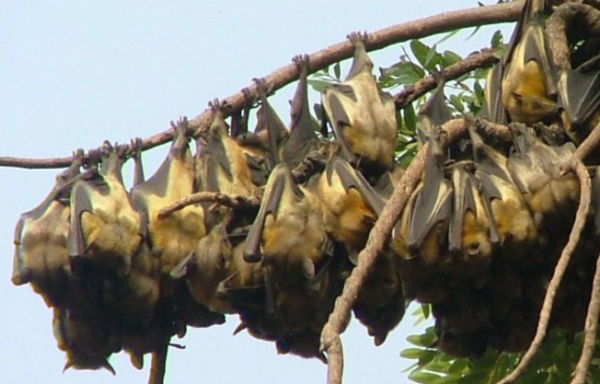A bat species may be more likely than a rodent to carry viruses known to jump from other animals to people, a new study suggests.

Per species, bats also harbor more known viruses in total than rodents do, including wildlife-only infections as well as those that also infect people, says Angela Luis of Colorado State University in Fort Collins. And a bat virus on average has a greater number of species it can infect, Luis and her colleagues report February 1 in Proceedings of the Royal Society B.
Recent years have brought headlines about scary viruses jumping from bats to people. The virus that caused the global SARS outbreak in 2003 and South Asia’s emerging Nipah virus have been traced to bats. Rodents, in the meantime, spread other emerging diseases such as hantavirus pulmonary syndrome and Lassa hemorrhagic fever.
The possibility that gruesome outbreaks may arise from bat viruses feeds worries about bats. “The public — and scientists — often suffer from saliency bias, where we remember dramatic events and believe they occur more frequently than other less-dramatic ones,” says veterinary epidemiologist Jonathan Epstein of EcoHealth Alliance, an environmental health nonprofit in New York City. So he welcomes the new study for starting to quantify comparisons of virus richness.
Luis and her colleagues analyzed scientific papers on viruses among the world’s 1,000-plus bat species and the roughly 2,000 rodent species. Even though more studies have been published on rodent viruses, bats still ended up with more documented viruses per species. On average, a kind of bat has 1.79 viruses known to infect people, and a rodent has 1.48.
Trying to tease out what might cause such viral wealth, the researchers found that among bats, species sharing a region with other kinds of bats were more likely to carry higher numbers of viruses. The same effect was not nearly as strong in rodents. Many bat species mingle in roosts, Luis notes, but “there’s not a place where rodents hang out together in the millions.”
That link between overlapping habitats and virus numbers suggests that people watching for emerging diseases might pay special attention to places with high levels of mammal diversity, notes Kevin Olival, also with EcoHealth.
Also, Olival points out, there are other animal groups to consider. There is no doubt that bats host many viruses that humans can catch, he says. “But I think many people would say the jury is still out on whether or not they are the most important group of mammals.”
Epstein cautions that biologists still don’t understand very much about bat physiology and immune systems. An important question that remains unanswered, he says, is whether bats are somehow more capable than rodents of carrying species-jumping viruses.
Regardless, Luis says, bats are “doing really important things” for ecosystems — and for people, such as saving farmers several billion dollars a year in pest-control costs by eating insects. Bats also pollinate plants.
The problem is not bats but people. When the fast-growing human population crowds into what once were wildlife-only domains, viruses have more chances to jump between species. As coauthor David Hayman says, “Putting some distance between people and bats may be good for both.”






